MXA RACE TEST: THE REAL TEST OF THE 2024 HONDA CRF450
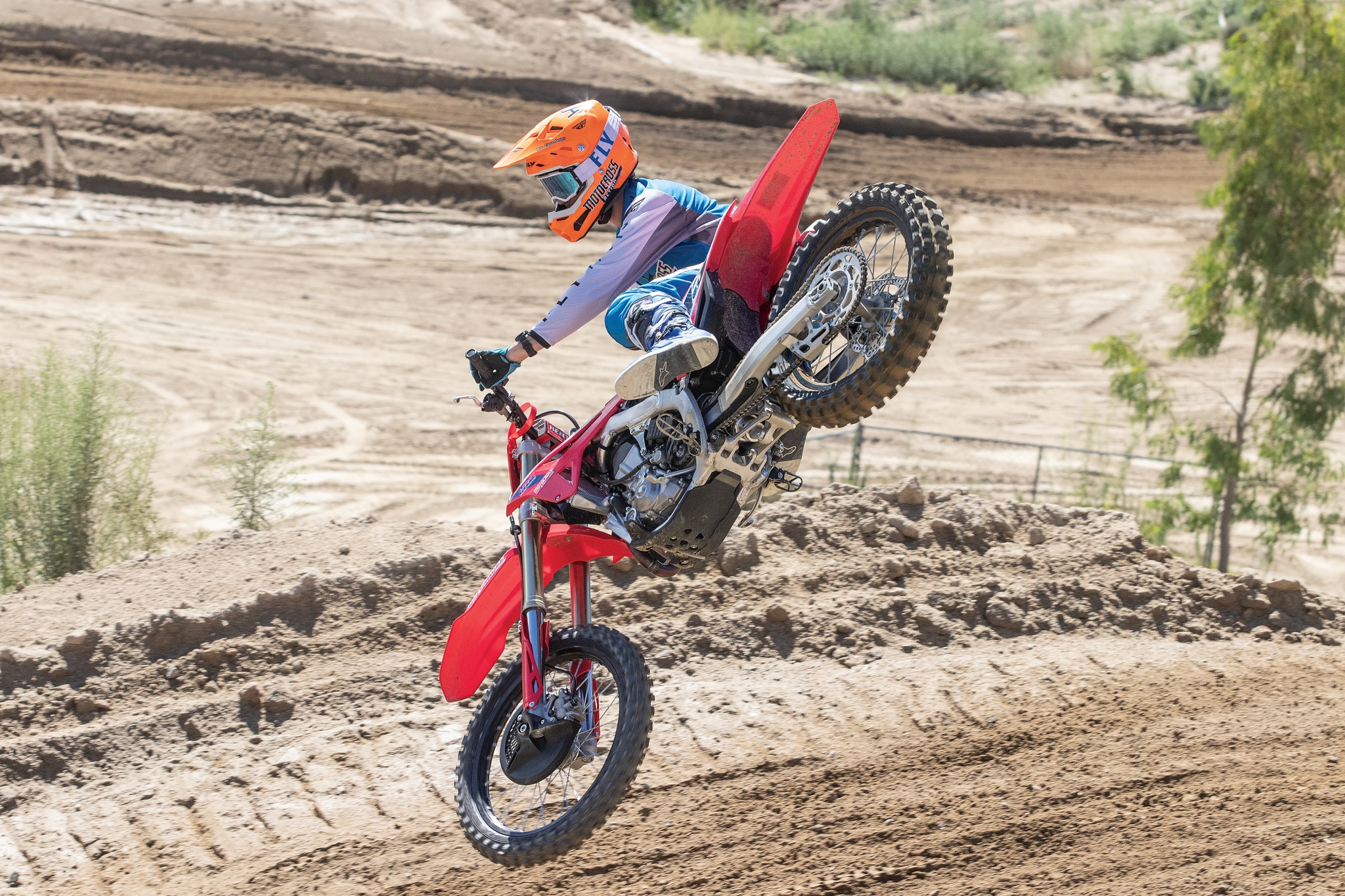
Q: FIRST AND FOREMOST, IS THE 2024 CRF450 BETTER THAN THE 2023 CRF450?
A: No, largely because the 2024 CRF450 is a 2023 CRF450.
Q: HOW MANY HONDA CRF450s ARE THERE?
A: There are six Honda CRF450 models that are based on the basic CRF450 motocross platform. They all use the CRF450 engine in different states of tune. Here is a breakdown of the six-pack of CRF machines for clarification.
2024 Honda CRF450. This is the base model of the six-bike lineup. It is the go-to model that takes up most of the floor space in Honda dealerships across the country. It gets the updated 2023 engine, frame and suspension packages, along with a five-speed transmission, hydraulic clutch, and 1.7-gallon fuel tank. It retails for $9,699.
2024 Honda CRF450 Works Edition. The 2024 CRF450 Works Edition starts life as a stock Honda CRF450 but gets an extensive list of premium upgrades, including a stainless-steel Yoshimura exhaust; hand-polished exhaust port; Hinson clutch basket and cover; Throttle Jockey seat cover; D.I.D DirtStar LT-XÅÇ rims; coated fork tubes, fork legs and shock; plus, an 18mm shock shaft and gray triple clamps. It retails for $12,499 (which is $2800 more than the $9699 stocker).
2024 CRF450-S. The CRF450-S is a previous model of the CRF450 offered at a reduced price to provide a more affordable entry into high-tech Honda 450cc machinery. It does not get the latest 2024 CRF450 engine, frame or suspension mods, but it was the high-end showroom stock CRF450 just two years ago. It retails for $8,899, which is $800 less than the $9,699 stocker.
2024 CRF450X. The off-road-ready CRF450X uses the base CRF450 Unicam engine but with a wide-ratio six-speed transmission, 18-inch rear wheel, side stand, hand guards, unique ECU mapping, larger 2-gallon fuel tank and more frame. It retails for $9,999, which is $300 more than the $9,699 CRF450 motocross version.
2024 CRF450RX. The 2024 Honda CRF450RX combines the enhancements of the 2023–2024 CRF450 motocross model and infuses it with engineering magic, like the off-road-tuned ECU mapping, wide-ratio five-speed transmission, plusher off-road suspension settings, an 18-inch rear wheel, Dunlop AT-81 tires, and a larger 2.1-gallon fuel tank. It retails for $9,999, which is $300 more than the $9,699 CRF450 motocross version.
2024 CRF450RL. This CRF450 version is fully street-legal (in all 50 states) and off-road capable. The 2024 Honda CRF450RL is equipped with a catalytic converter, six-speed transmission, high-intensity projection headlight and rear-view mirrors. It is a capable dual-sport machine. You can ride it wherever it’s legal to operate a motor vehicle, and that includes on Interstate highways, down to the corner store to pick up a loaf of bread or to investigate any off-road trail you want. It retails for $10,099 (which is $400 more than the $9,699 CRF450 motocross version).
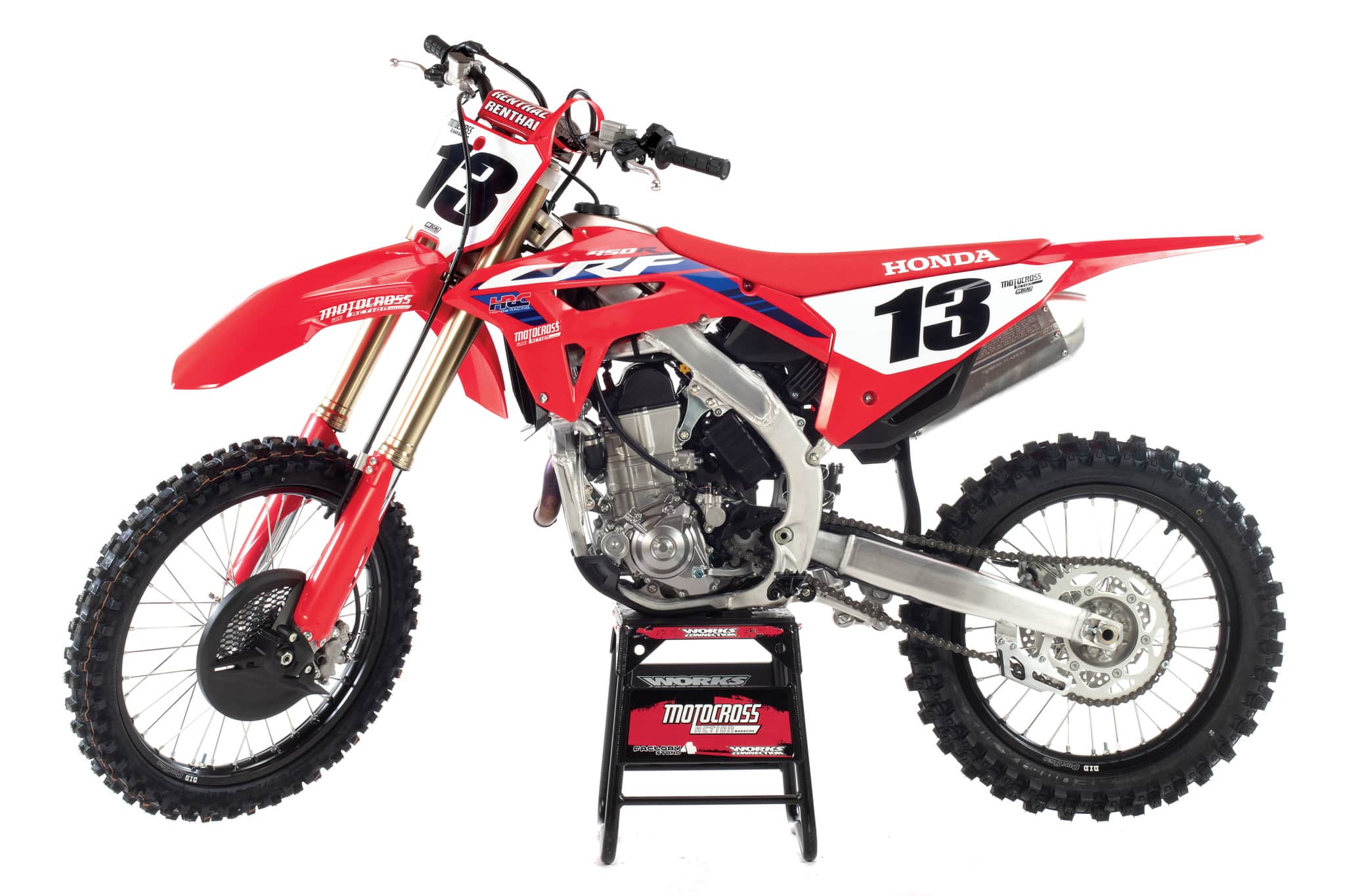
Q: WHAT DID HONDA CHANGE ON THE 2023–2024 CRF450?
A: With some substantial changes in 2023, the 2024 CRF450 received no updates for 2024. You might be interested in the 2023 changes, since they play a major role in how the 2024 model works.
Frame. You won’t see any visible changes to the frame, but the forged bridge strut that connects the frame’s down tube to the extruded rectangular tubes of the frame cradle has been made 2mm thicker (from 4mm to 6mm), while the shock tower forging, where it connects to the top of the shock, is also 2mm thicker. These two forgings don’t add much to an already too-stiff frame.
Shock. For 2023 (and thus 2024), the shock spring was upped from a 54 N/mm spring to a 56 N/mm spring. This is best suited to heavier or faster riders, but most MXA test riders felt that the stiffer rear shock overpowered the forks.
Fork. The 2023 Showa fork mods were not a step in the right direction. The fork was too soft in the first half of the stroke and too rigid in the second half. The forks did not offer progressive damping throughout the stroke. Getting the front to work in sync with the rear and finding the proper balance was only possible on a smooth racetrack.
Engine. The 2023–2024 frame, shock and fork updates were mostly strikeouts, but the engine mods were a home run. Here is what engineers did to the 2023-2024 engine:
(1) The intake port’s shape was made narrower and smaller.
(2) The cam got a revised lobe profile to increase torque and broaden the powerband’s responsiveness.
(3) Honda lengthened the air boot and added a longer velocity stack-style trumpet inside the air boot.
(4) The Keihin throttle body’s venturi diameter was reduced from 46mm to 44mm.
(5) Miscellaneous. The head stays were changed from aluminum to steel. The muffler perf core was changed from round perforations to louvered perfs. The ECU mapping was changed.
(6) Honda’s 2023 engine modifications produced a gentler style of power. The ultra-linear powerband was, in a word, awesome; however, there was a price to pay for all of Honda’s detuning. The 2023–2024 CRF450 engine topped out at 56.9 horsepower at 9100 rpm. It gave up 3 horsepower, not just to previous CRF450s, but also to the 60-horsepower KTM 450SXF and 59.30-horsepower Husqvarna FC450.
You would think MXA would be disappointed in the 2023–2024 powerband, but au contraire! Not only did it do what Honda’s engineers designed it to do, it also did what the MXA wrecking had been asking for since the previous brutal 60-horsepower versions. Not only is this a great engine, but it does the impossible by taming some of the CRF450 frame’s skittishness. 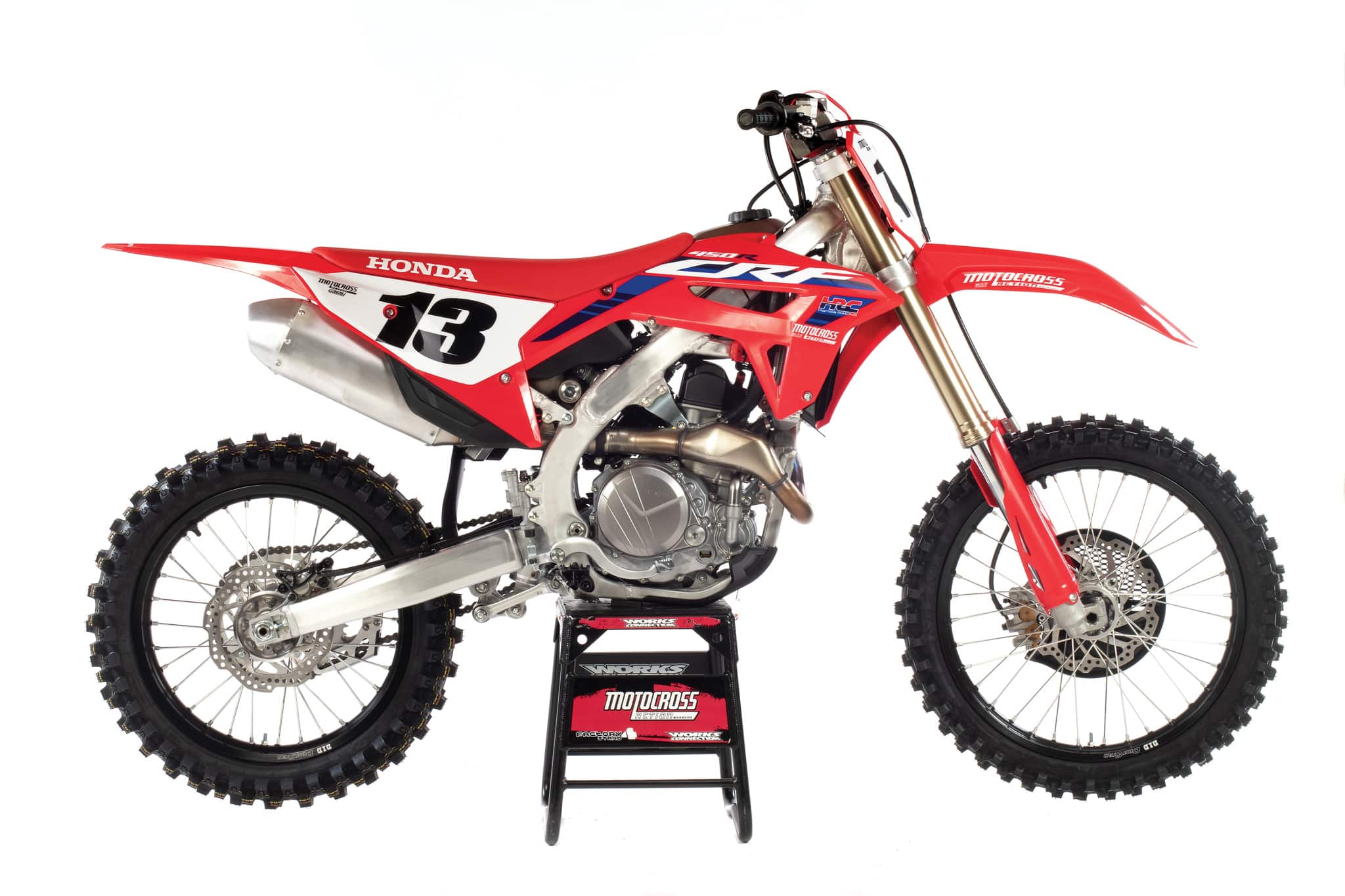 Q: WHAT IS THE 80-PERCENT EQUATION?
Q: WHAT IS THE 80-PERCENT EQUATION?
A: In short, the Honda CRF450’s absolute worst traits exhibit themselves when the CRF450 is pushed by a rider above 80 percent of its capabilities or 80 percent of his. If you stay below 80 percent, the Honda chassis is gentlemanly. It is only at speed that the combination of an overly rigid frame, unequal suspension settings and the frame’s harmonic imbalance make the Honda difficult to ride. It is at this pace that the frame starts to twitch, and once the front wheel starts to dance, it does unexpected things. The best CRF450 riders can make the CRF450 work like magic, but they tend to be smooth, precise and talented riders who choose to let the CRF450 flow by depending on consistent speed to make the bike work—think Jett Lawrence.
We like the 2024 powerband, because the throttle is more connected with the rear wheel. It takes out the hypersonic rpm and quasar horsepower of the previous engines and allows even the most maladroit CRF450 rider to get 80 percent out of the engine without having to pay the 100-percent price.
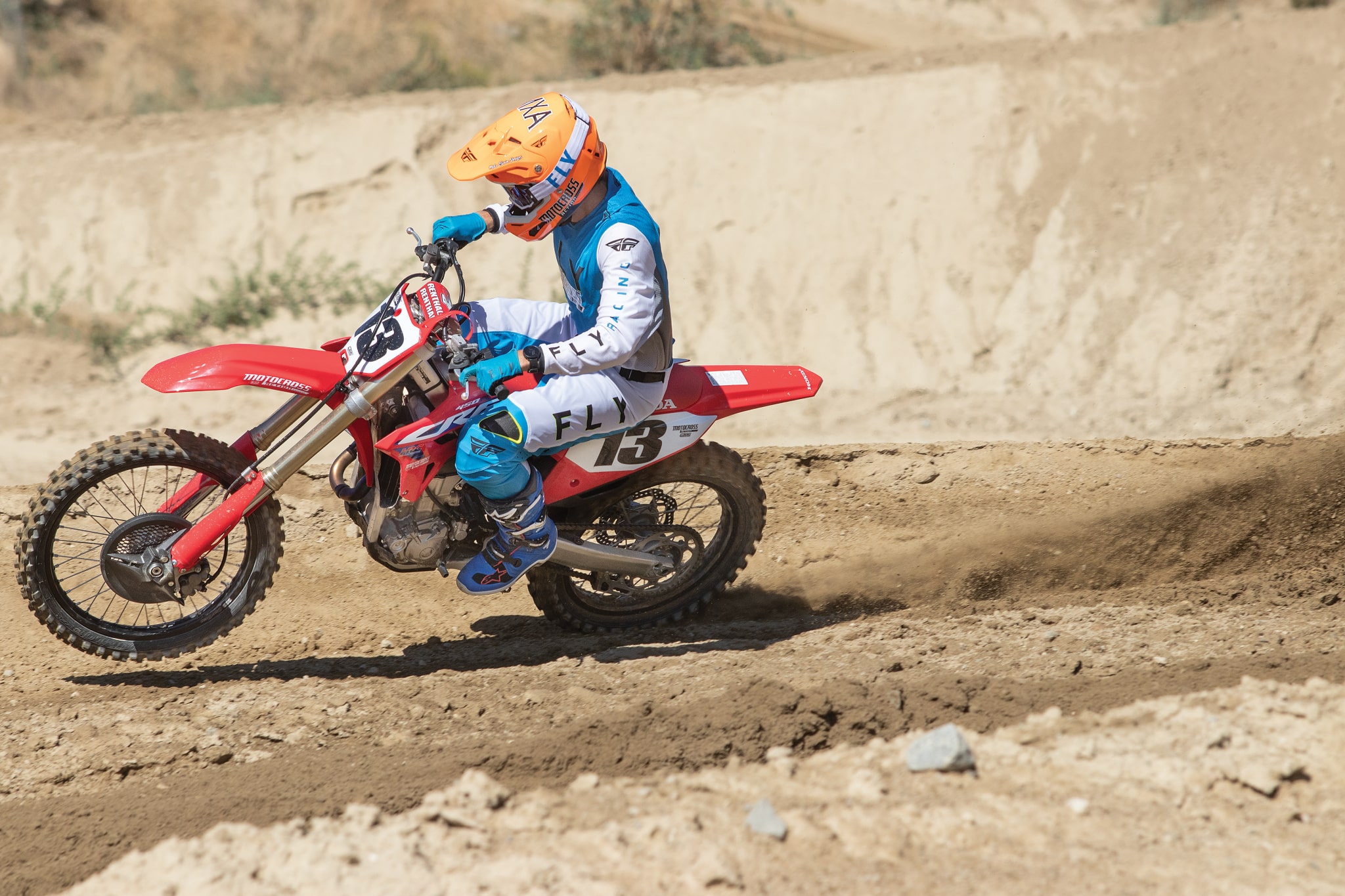
Q: DOES THE 2024 HONDA CRF450 HANDLE?
A: The 2024 CRF450’s best-handling trait is at turn-in. It can tuck into the tightest corner and attack inside lines like a champ; however, it is scary loose at speed over rough ground. If you ride it fast, like at 81 percent of its performance envelope, you are going to suffer some frightening moments when it seems to have a mind of its own.
When you add in Honda’s 30-year tendency to head-shake going back to the Jeremy McGrath days, you have a bike that works best on smooth dirt or Supercross-style layouts.
Every MXA test rider slides the forks down in the triple clamps until they are flush. This makes the head angle slacker, which improves straight-line stability and, amazingly, doesn’t hurt the CRF450 at turn-in (this setup works very well on the 2023–2024 Yamaha YZ450F also).

Q: WHAT IS THE BEST MAP SETTING?
A: The CRF450 offers three different map settings (standard, mellow and aggressive). Here is the rundown:
(1) Standard map (one flash). Every MXA test rider preferred to run the Standard map in most situations. It offered the broadest spread of power and produced 56.9 horsepower.
(2) Mellow map (two flashes). The Mellow map is just as advertised. On the dyno, the mellow map gave up 1 horse across the rpm range and peaked at 55.97 horsepower.
(3) Aggressive map (three flashes). The Aggressive map is certainly more exciting off the crack of the throttle, but it actually produced less horsepower than the standard map from top to bottom and detonated when pushed hard.
Q: WHAT ABOUT THE SUSPENSION?
A: Over the last three model years, Honda’s Showa forks have been too soft (2022), too harsh initially, too soft late in the stroke (2023) and too soft initially and too harsh in the mid-stroke (2024). It’s as though Honda’s engineers are just moving the harsh spot around every year. We have to wonder how long it will take before they stumble on to a fluid, progressive damping curve. Face it, none of the Showa coil spring forks can compete with Yamaha’s Kayaba SSS forks or even WP’s latest XACT air fork.
As for the Showa shock, it has more potential than the forks, but there are a few caveats.
(1) You can make the shock work better, even in the stock setup, by changing to a Pro Circuit CRF450 shock linkage. It changes the rising-rate curve to smooth out the travel.
(2) If you are like most motocross racers, you probably set your sag at 105mm; however, the 2024 Honda CRF450 has fore/aft balance issues, and MXA has test riders who, depending on their speed or weight, will run 102mm or 108mm (skirting 105). Unfortunately, this requires CRF450 owners to actually test different sag settings to find the setup that works best for their speed, weight, riding style and track conditions.
(3) Not everyone was happy when Honda dropped the 54 N/mm shock spring for the stiffer 56 N/mm. Lighter riders might find happiness by going back to the 54, and it goes without saying that the big boys (over 220 pounds) will need Honda’s optional 58 N/mm spring.
Q: WHAT DID WE HATE?
A: The hate list:
(1) Shift lever. The CRF450 shift lever is 17mm shorter than a KTM shift lever. It is much harder to get your boot under it in high-stress situations.
(2) Electronics. There are three settings available for every function. It was information overload, and lots of riders ignored the flashing lights.
(3) Air filter. The upside-down design of the air filter looks cool, but it’s not. Not only does it get dirty faster than any other filter, but Team Honda doesn’t run it. They 3D printed a new airbox that holds the filter in the traditional forward-facing position.
(4) Exhaust flange. The studs backed out of the head when we removed the exhaust system. We threaded them back in with Loc-Tite.
(5) Radiators. We boiled water in the radiator until we installed a Twin Air 1.8 radiator cap instead of the stock 1.1.
(6) Balance. We got dizzy trying to find a good fore and aft balance. A change to the front ruins the rear and vice versa.
(7) Pinging. The new mapping was crisper and cleaner than in the past, but it pinged in the Aggressive map. Probably not a big concern in cool weather with a Vet in the saddle, but keep an ear out anyway.
(8) Grips. If you like hard grips, you will love the old-school Honda grips.
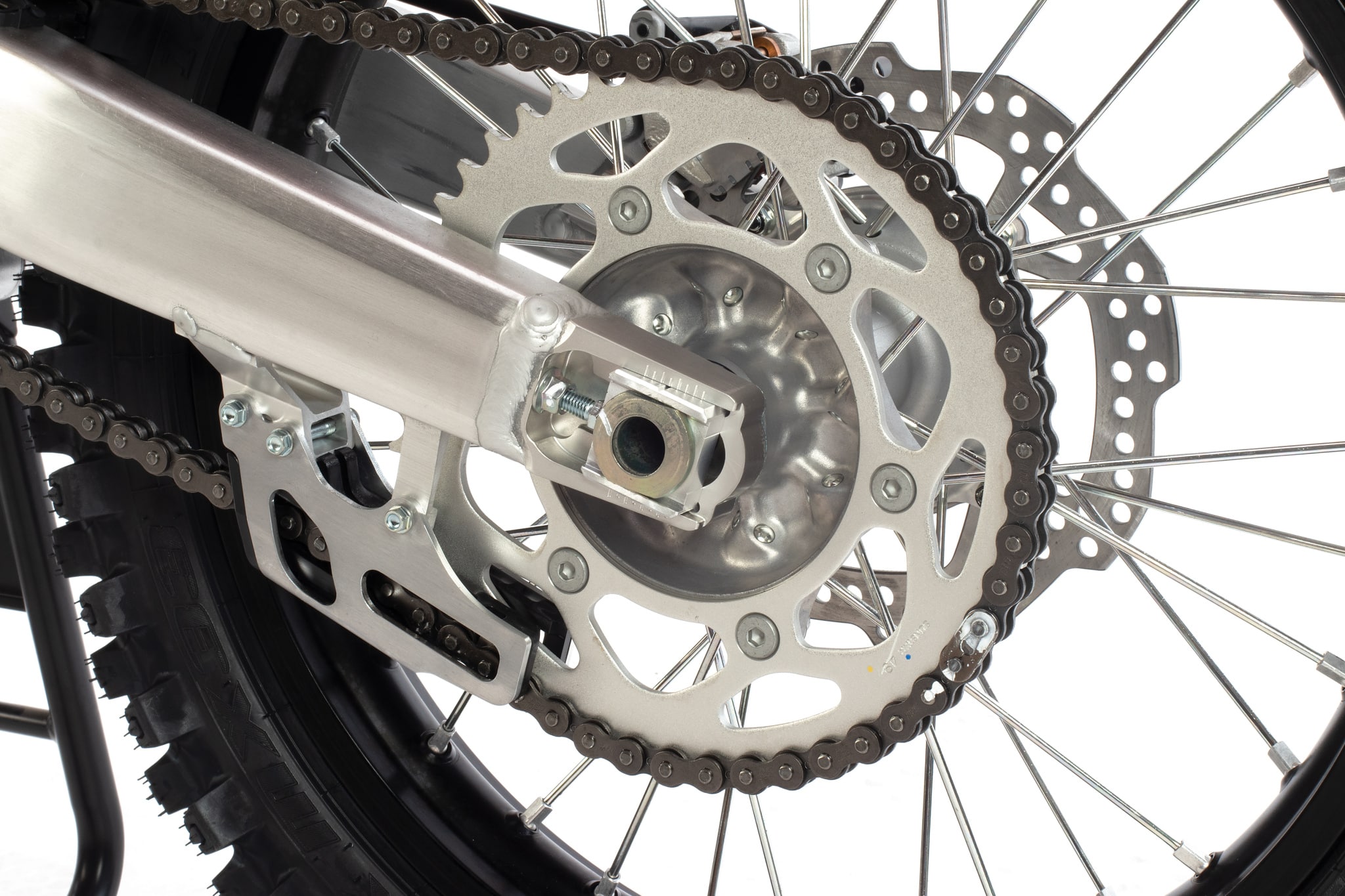
Q: WHAT DID WE LIKE?
A: The like list:
(1) Engine. We loved it! We have been waiting for a usable Honda powerband for years; instead, they gave us violent, uncontrollable, 60-horsepower beasts that wreaked havoc on the Honda chassis. The new powerband is ultra-usable, doesn’t overpower the rigid chassis and allows the rider to choose the speed he wants.
(2) Ergonomics. The rider triangle, bodywork and saddle are perfect for every body type—from endomorphs to ectomorphs. Only the short shift lever is a faux pas.
(3) Maps. The multiple maps, launch control settings and traction control rev limits verge on overkill, especially because we prefer the standard map for most situations. Still, it is nice to have options—to ignore if nothing else,
(4) Gearing. Choosing the correct gear ratio is dependent on track layout and rider skill level. The stock 13/49 gearing is in the ballpark, but some test riders preferred 13/50.
(5) Launch Control. Unlike most launch control systems that retard the ignition to keep the engine from making max power when launch control is engaged, Honda offers four different rev limits for rpm: 8,250 rpm, 9,500 rpm, 9,800 rpm and 10,700 rpm.
(6) Traction Control. Honda’s ECU monitors runaway revs and responds to them by retarding the ignition to stop wheelspin. Mode 1 interacts later and lighter. Mode 2 responds quicker with more intervention. Mode 3 cuts power instantly for slippery or muddy terrain.
Q: WHAT DO WE REALLY THINK?
A: Although we had long-standing issues with some aspects of the 2024 Honda CRF450’s setup in the handling and suspension departments that every Honda owner will recognize, we truly believe that this a better CRF450 than those of the last three years. The swing votes in favor of the 2024 model were a massive “yay” for the all-new power profile, the flawless ergonomics and the solid running gear.



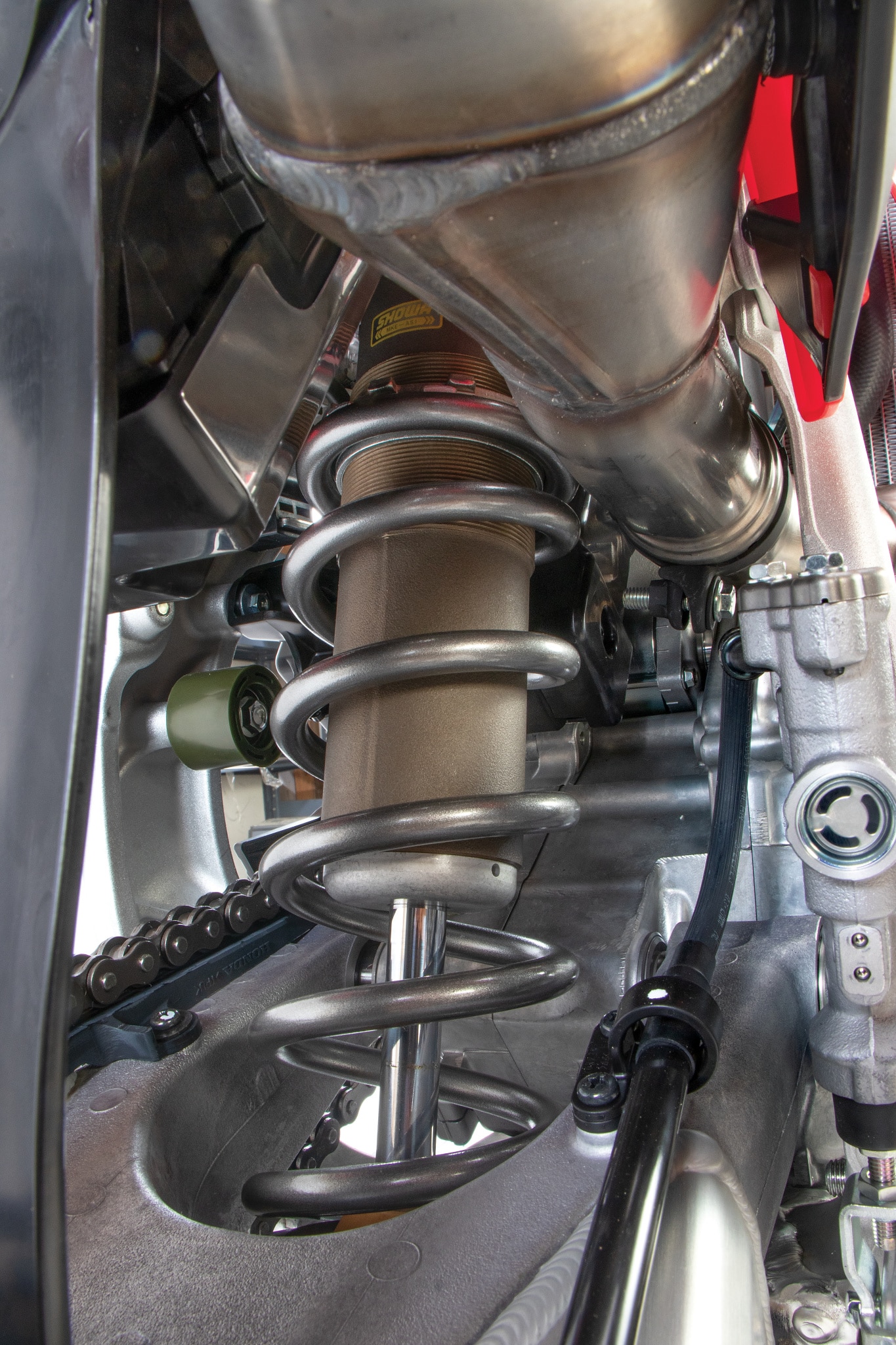

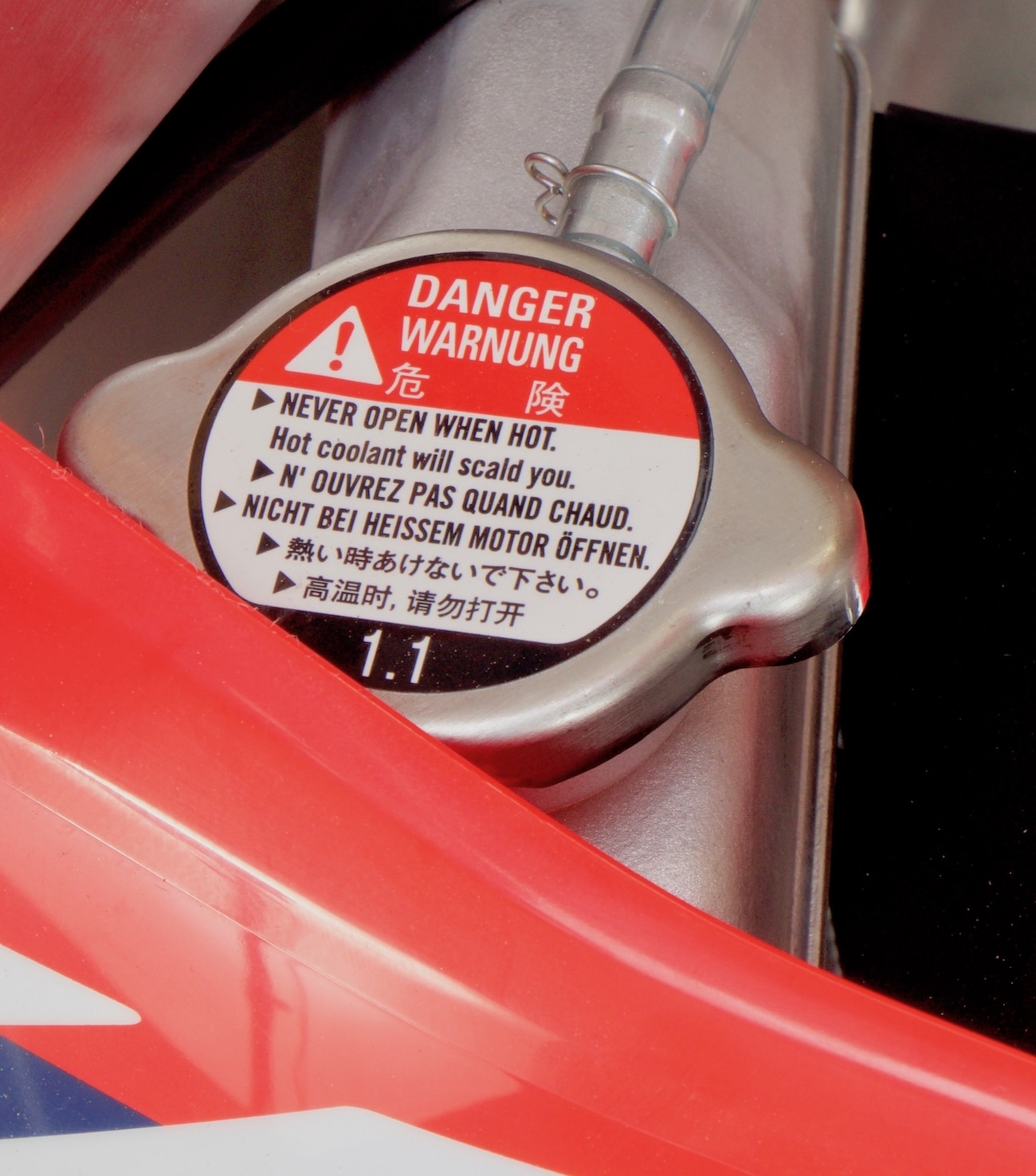
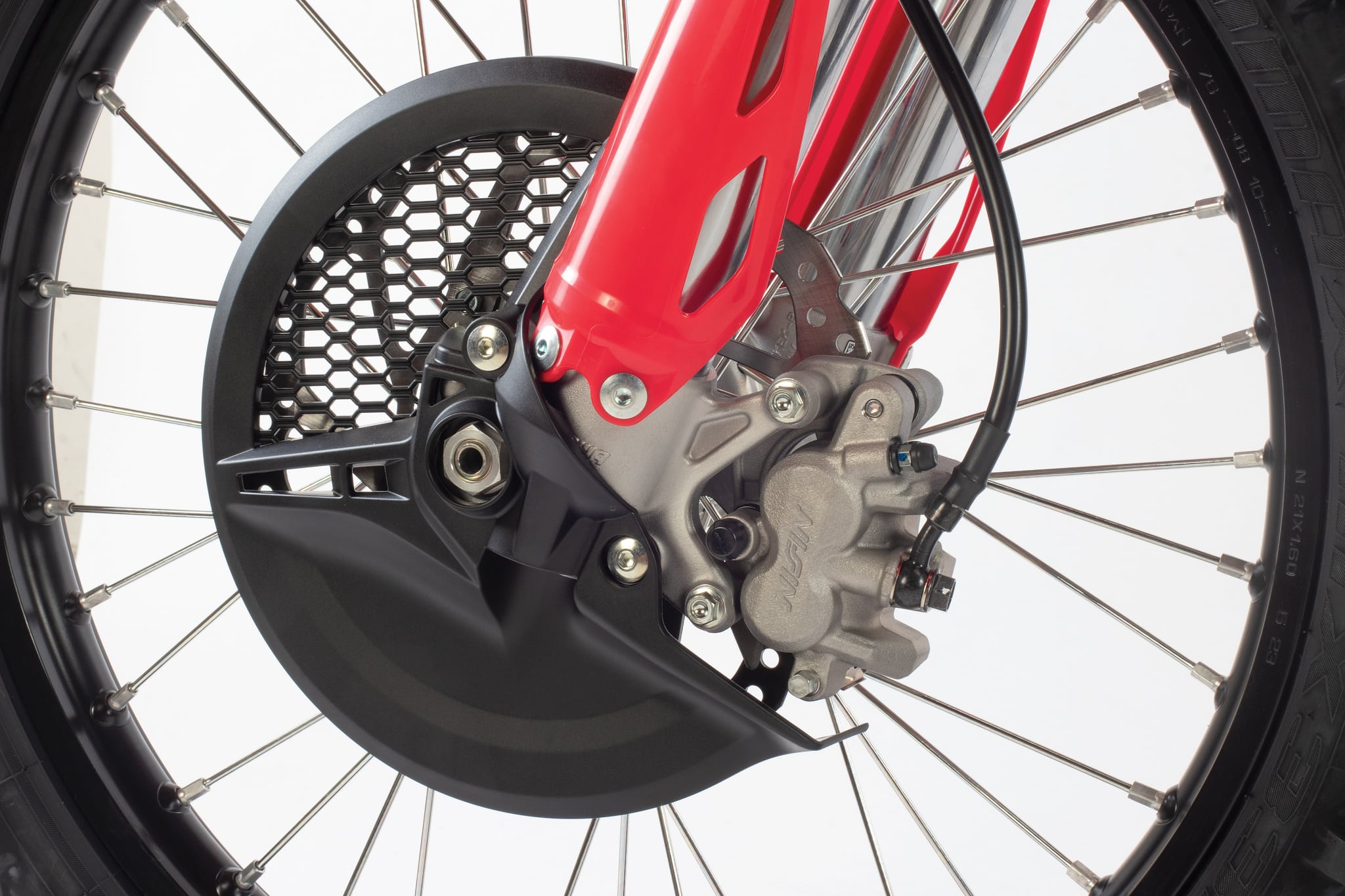
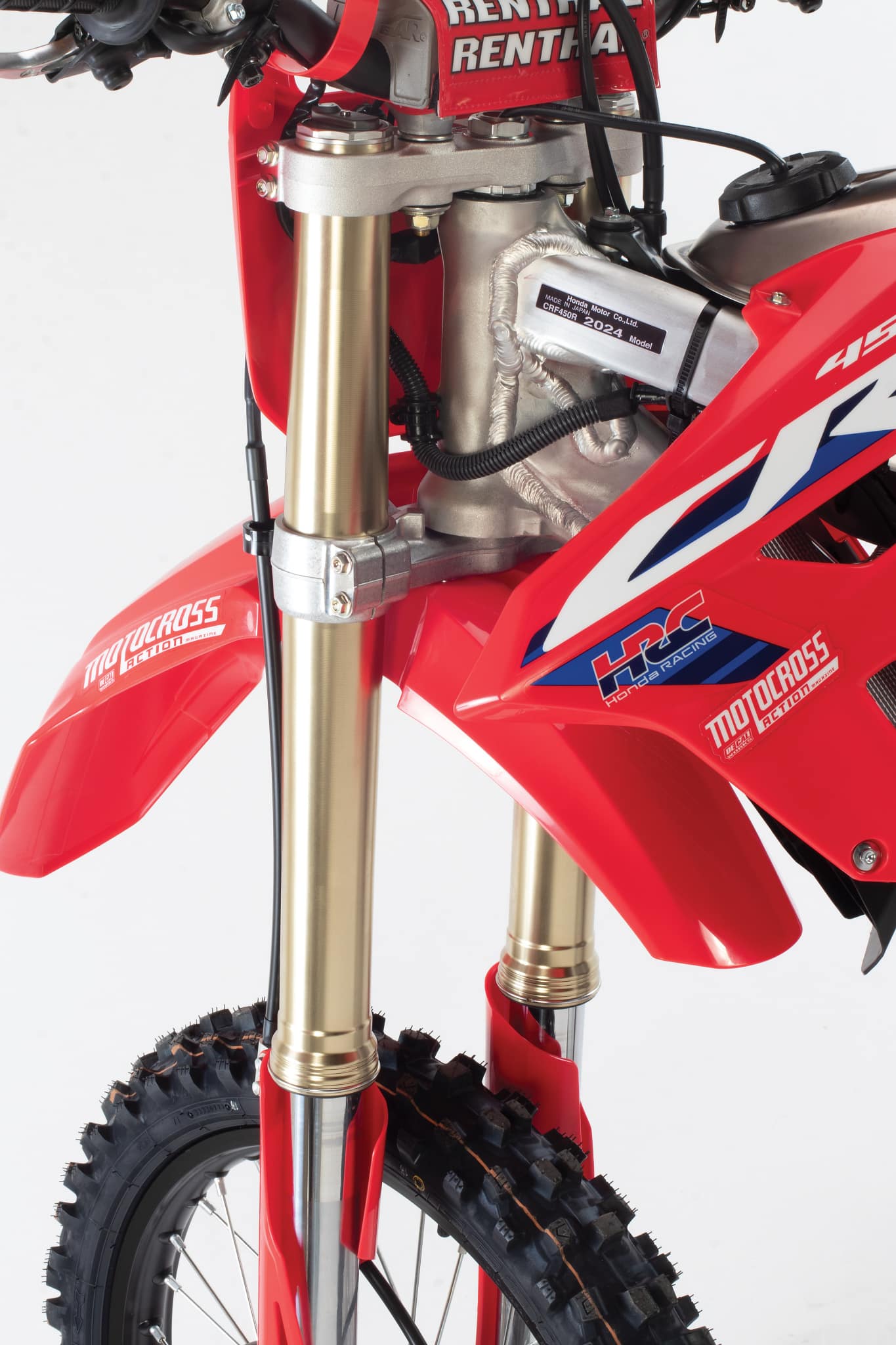



Comments are closed.